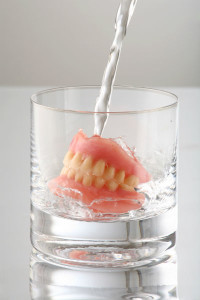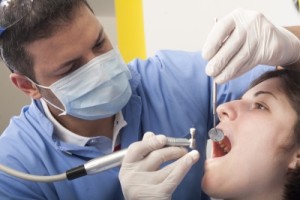 Dentures have been around since the 7th century BC when the Etruscans in northern Italy made partial dentures out of human or animal teeth fastened together with gold bands. The Romans expanded on the practice. Wooden full dentures were invented in Japan in the early 16th century. Probably the most famous denture wearer was George Washington, whose famous chompers were made with ivory from hippos and elephants, gold rivets, spiral springs, and real human teeth.
Dentures have been around since the 7th century BC when the Etruscans in northern Italy made partial dentures out of human or animal teeth fastened together with gold bands. The Romans expanded on the practice. Wooden full dentures were invented in Japan in the early 16th century. Probably the most famous denture wearer was George Washington, whose famous chompers were made with ivory from hippos and elephants, gold rivets, spiral springs, and real human teeth.
Surprisingly, one quarter of the U.S. population over 65 years of age have lost most or all of their natural teeth. Many of those people, unfortunately, have learned to live without teeth, with the corresponding damage to their ability to eat certain foods, to speak clearly, and to their social life and overall self-esteem.
But it doesn’t have to be that way — dentures, whether full or partial, can give you back a beautiful, functional smile. At EMA Dental, we offer full dentures, partial dentures, and implant-retained dentures. Although fully replacing teeth with implants is preferable, dentures can surely be a cost-effective alternative.
Benefits of dentures
Expertly designed, well-fit dentures from EMA Dental can have a dramatic impact on your quality of life. Dentures can:
- Improve your ability to chew and bite properly and make it easier to eat a healthy diet rich in crunchy fruits and vegetables.
- Help you look more youthful with the restoration of your gums, teeth, and jawbone.
- Improve your self-esteem. You can smile and laugh without feeling embarrassed about the way you look.
- Make it easier to communicate and speak clearly.
Partial or full
If you have at least one remaining tooth in the upper and lower jaw, partial dentures will probably be your best option. With partial dentures, crowns are put on top of the remaining natural teeth, serving as anchors for the artificial teeth in between. Partial dentures fill the spaces created by the missing teeth and also prevent the remaining teeth from moving into those open spaces. Partial dentures can be removable or permanent, depending on the number of remaining teeth.
Full dentures replace all of your teeth. Any remaining badly damaged or decayed teeth are removed and then various impressions are taken to use when constructing the dentures, which can take about two months. Full dentures are held in place through pressure provided by the tongue and cheeks, and suction. Adhesive can be used to add stability. That’s why it’s important to have your dentures constructed and fit very precisely.
Implants + dentures
Denture technology is moving toward using dental implants to anchor dentures. Implants are titanium posts that are inserted into the former tooth sockets. The jawbone is allowed to grow back around the implants, making them similar to natural tooth roots. The dentures attach to those implants, which are placed at various necessary support positions in the upper and lower jaw. Implant-supported dentures have several advantages:
- Dentures don’t move, rub, and cause irritation because they are anchored in place by the implants.
- The dentures don’t slip when speaking, biting, or chewing.
- Because they don’t slip, food debris doesn’t get stuck under the dentures while eating.
- The risk for bone loss is reduced, as implants maintain the normal downward pressure that stimulates the jawbone.
- Lower jaw dentures are more stable compared to traditional prosthetics.
See, now you’re a denture expert. If you’re missing an assortment of teeth, one of these denture options from EMA may be the way to go. Call either our Longmeadow or Northhampton office to schedule an appointment for us to take a look and discuss your options.

 Most people have heard of a crown, but they don’t really know what they are, beyond something Prince Harry will one day wear!
Most people have heard of a crown, but they don’t really know what they are, beyond something Prince Harry will one day wear!